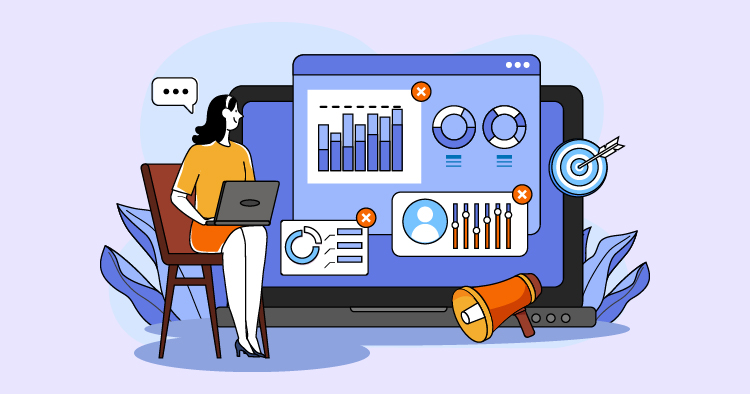Google Ads is a critical player in marketing, offering tools that help businesses reach the right people. One standout feature is the “similar audiences” option. It’s like having the ability to clone your best customers and then reach out to new people who are just like them. By diving into similar audiences, you can tap into groups of potential customers likely interested in your offer. This guide will walk you through the advantages of using similar audiences in Google Ads and show you how to use them to improve your ads and get better results.
Understanding Similar Audiences
Similar audiences in Google Ads are like finding new friends who share the interests and habits of your current friends. When you use Google Ads, you reach out to people who act like your website visitors or have interacted with your ads. Google’s intelligent tools look at what your audience likes and does, then find new people who behave similarly.
Imagine you have a group of customers who love your handmade soaps. Google notes what these soap lovers look at online, what they search for, and their other interests. Then, it uses this information to find new soap enthusiasts who haven’t discovered your brand yet but are likely to be interested.
Benefits of Targeting Similar Audiences
When you target similar audiences, it’s like throwing a wider net to catch more fish like the ones you’ve already seen. This way, you’re not just talking to the same people repeatedly; you’re reaching out to new potential customers who will probably be interested in what you’re selling because they’re similar to your current customers.
This smart targeting means that the new people seeing your ads will likely be interested in your products, as they share interests with your existing customers. Therefore, they are more inclined to purchase, leading to more sales and a more substantial return on your advertising investment. It’s a way of making your marketing efforts count by focusing on people more likely to say “yes” to your products.
Identifying Similar Audiences
When you want to expand your reach in Google Ads, it’s brilliant to find audiences that resemble your current customers. Start by digging into your customer data. What do they have in common? Maybe it’s their shopping habits, the type of content they consume, or specific interests they share. By pinpointing these traits, you can discover new users cut from the same cloth.
Understanding your target audience’s interests and behaviors is critical. It’s like having a roadmap to their preferences and needs. With this knowledge, you can craft ad campaigns that hit the mark, appealing to people who are just like your current customers but haven’t discovered your brand yet.
Creating Similar Audiences in Google Ads
Are you ready to create similar audiences in Google Ads? First, you need a solid foundation, which means having a good-sized group of existing customers or users. With this in hand, head to the Google Ads Audience Manager. Here, you can set up new audiences that mirror the characteristics of your existing ones.
Find opportunities to optimize your Google Ads campaigns
- Data-Driven Approach
- Expert Insights
- Unbiased, Fresh Perspective
- Optimized for Your Goals
You’ve got plenty of choices for shaping these similar audiences. Maybe you want to target people who’ve visited your website, used your app, or engaged with your YouTube channel. Each path offers a unique opportunity to connect with potential customers who are likely to take an interest in what you’re selling. By tailoring your approach, you can reach out to people primed to become your next loyal customers.
Refining Similar Audiences
Keeping a close eye on their performance is essential to get the most out of your similar audiences. This means looking at significant numbers like how often people click on your ads (click-through rate) and how usually these clicks lead to something valuable, like a sale (conversion rate). If these numbers are good, your audience is probably a good match for your offering.
But don’t just set up your audience and forget about it. You should make it a regular task to check how your audience criteria are doing and change them if necessary. This helps ensure that your ads continue to reach the right people. By testing different settings and monitoring the results, you can keep improving your targeting, leading to better campaign results.
Leveraging Google Ads Lookalike Audiences
Lookalike audiences in Google Ads are a powerful tool for reaching more people. They work with similar audiences but are designed for more prominent campaigns. These audiences are created using a wide range of data about user’s behavior and interests.
Using lookalike audiences, you can connect with a larger group of potential customers likely to be interested in your offerings. These audiences are people who are similar to your existing customers. When you use lookalike audiences, you can expect to see an increase in the number of people seeing your ads, which can lead to more clicks and potentially more sales, making your advertising efforts more effective overall.
Setting Up Lookalike Audiences
Creating lookalike audiences is a powerful way to reach new people who are likely to be interested in your business because they’re similar to your best existing customers. Here’s how you do it:
First, pick a source audience. This could be a list of your best customers, people visiting your website, or users engaging with your content. Choosing a group that genuinely reflects the customers you want to attract is essential.
Find opportunities to optimize your Google Ads campaigns
- Data-Driven Approach
- Expert Insights
- Unbiased, Fresh Perspective
- Optimized for Your Goals
Next, head to your advertising platform, like Google Ads, and look for the option to create a lookalike or similar audience. The platform will then analyze your source audience and find new people who share characteristics with your best customers.
Remember, balancing reaching enough people and keeping your audience relevant is crucial. If your source audience is too broad, your lookalike audience may not perform well. So, make sure your source audience is a good match for your ideal customer profile.
Combining Similar and Lookalike Audiences
Mixing similar and lookalike audiences can significantly extend your marketing campaign’s reach while still talking to the right people. This method helps you find more potential customers likely to be interested in your offer.
How do you do this effectively? Use each type of audience for what it does best. For example, if you’re running a campaign to get people to take a specific action, like signing up or making a purchase, you might lean on similar audiences. They are usually more precise and can help you find people who are more likely to convert.
On the other hand, when you want to promote your brand and introduce yourself to a broader audience, lookalike audiences are your friends. They help you cast a wider net and ensure more people learn about your business.
It’s all about matching your campaign’s goals with the right audience strategy. This allows you to tailor your campaigns to either zero in on conversions or broaden your brand’s visibility, depending on your needs.
Optimizing Ad Creatives for Similar Audiences
When reaching out to audiences similar to your current customers, it’s essential to ensure your ads speak to them. Consider what these potential customers might like or be interested in, and use that to guide how you create your ads. For example, if you know they’re interested in outdoor activities, you might use images of nature and adventurous language in your ads.
It’s also a good idea to test different versions of your ads to see which ones get the best response. This is called A/B testing. You can change the words, images, or even the layout of your ads and then see which version gets more people clicking or buying. Doing this lets you determine the best way to get people interested in your offering.
Tracking and Analyzing Similar Audience Performance
Once you start showing your ads to similar audiences, you’ll want to watch how they do. There are a few key numbers to watch, like how often people click on your ads (click-through rate), how usually those clicks lead to sales or sign-ups (conversion rate), and how much you’re spending to get a new customer (cost per acquisition).
By looking at these numbers, you can see whether your ads are hitting the mark. Are people interested? Are they taking the action you want them to take? You can look for patterns, like if certain ads do better at certain times or if one type of ad works better. This can help you make smarter decisions about your ads in the future so you can keep improving and getting better results from similar audiences.
Audience Expansion Strategies
Expanding your audience is essential for business growth. One effective way to do this is by finding new groups of people with interests and behaviors similar to those of your current best customers. You must watch for these changes as consumer habits shift and adjust your targeting strategies accordingly. This will ensure that your marketing efforts are constantly hitting the mark.
You can use tools and analytics to discover new audience segments to stay ahead. Engaging with these new groups can help you tap into markets you haven’t reached before, potentially increasing your customer base and driving more sales.
Common Mistakes to Avoid
It’s easy to cast too wide a net when trying to reach more people. If you’re not careful, you might target a vast audience, which can dilute your marketing efforts and lead to less effective campaigns.
Another standard error is not customizing your advertisements to resonate with the specific interests and needs of the new audience. People want to see ads that speak to them directly, and if your ads don’t do this, they may not perform as well as they could.
To avoid these issues, regularly review and refine the target audiences of your ads. Ensure your ads appeal to the particular groups you aim to reach. By keeping your audience and ad content well-aligned, you’ll be more likely to engage potential customers and encourage them to take action.
Best Practices for Leveraging Similar Audiences
When working with similar audiences, it’s crucial to keep your audience segments fresh. This means updating them regularly to reflect changes in user behavior and preferences. Also, try various ad formats and creative elements to see what resonates best with your audience. It’s like trying different keys on a lock until you find the one that turns.
Monitoring how your ads perform is vital. Look at the data closely to understand what’s working and what’s not. This information can help you make informed decisions about your advertising strategy. Think of it as having a map that guides you through the terrain of your customer’s interests and behaviors.
Be ready to change your tactics when needed. If you notice that specific targeting parameters do not yield the desired results, don’t hesitate to tweak them. It’s all about being adaptable and learning from your experiences.
Lastly, ensure that the messages in your ads speak directly to the interests and needs of the similar audience you’re targeting. If your audience is interested in eco-friendly products, highlight your product’s green features in your ads. It’s about connecting what your audience cares about and what you have to offer.
Staying Ahead of the Competition
For small businesses, using similar audiences can be a game-changer. It allows you to pinpoint potential customers who are likely to be interested in what you’re offering. This precision in targeting can give you an edge over your competitors, as you’re reaching the right people more effectively.
To stay competitive, it’s essential to keep up with the latest developments in Google Ads and digital advertising in general. This means reading up on new features, strategies, and trends.
By staying informed and applying what you learn to your Google Ads campaigns, you can keep your business a step ahead in the competitive world of digital advertising. It’s like being a captain on the sea; you need to know the currents and winds to navigate your ship to success.
Final Thoughts
Getting the hang of similar audiences in Google Ads could make a difference in your business’s online growth. It’s all about watching how similar audiences are doing and tweaking them to keep your campaigns sharp. Ensure you’re constantly checking your campaign performance, tweaking your approach when necessary, and keeping up with Google Ads updates to stay ahead of the game. If you play your cards right, similar audiences can open doors to new possibilities and help your digital marketing efforts thrive.



